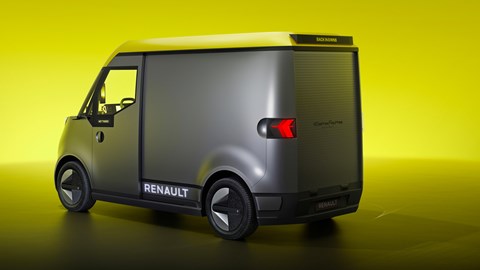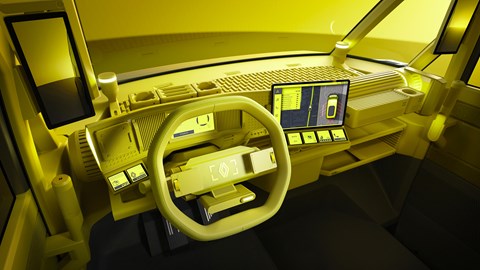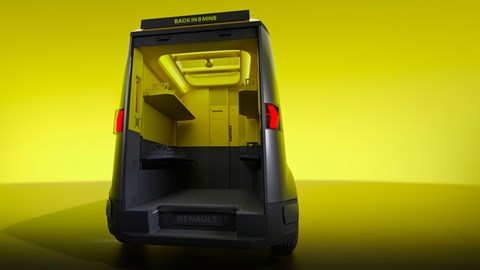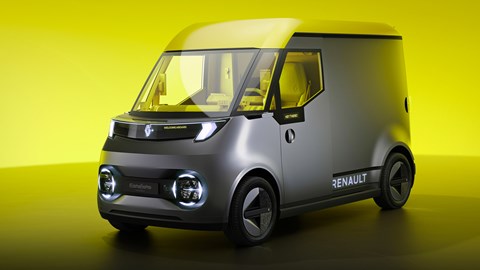► Estafette Concept returns to Renault van past
► Maximises space efficiency for urban deliveries
► Uses new FlexEVan platform with SDV tech
Europe’s biggest commercial vehicle show is happening right now – the IAA in Germany – and in among the worthy, heading-for-an-industrial-estate-near-you production fodder, Renault has sprung a surprise with this new Estafette 4.0 electric van concept.
If you’re not up on your van history (for shame, etc), the original Renault Estafette was a bit of a gamechanger when it was introduced in 1959. Front-engined and front-wheel drive, it brought an improved level of space efficiency to the burgeoning mid-size van market.
Now Renault is hoping to pull off a similar trick to improve the space efficiency of small, urban-friendly electric vans. For the new Renault Estafette Concept doesn’t just look cute, it’s also rather clever. And, we’re told, heading for production ‘in two years’ time’.
Get the cute looks part, but what makes it so clever?
Small electric vans make a lot of sense for city deliveries – zero emissions combined with nippy performance and compact size is great for darting about and getting stuff to peoples’ doorsteps. But if the van is so small you need to send two, then a bigger van is more economically viable… until that bigger van isn’t nimble enough to get the job done without, perhaps, risking increased levels of in-service damage.
With the Estafette Concept, Renault has approached saving this by creating a vehicle with a footprint similar to a long-wheelbase Renault Kangoo, the firm’s current small van. At under 5m in length and 2m width, the Estafette will still fit into most ordinary parking spaces and has a turning circle similar to a Renault Clio.

But thanks to a dramatically increased roof height, it has load space equivalent to a short-wheelbase, high-roof Renault Trafic – Renault’s present competitor to the Ford Transit Custom. For comparison, the Estafette is 2.59m tall versus the Kangoo’s 1.84m. In fact, it’s around 60cm taller than most Transit Customs and VW Transporters you see on the road.
This would create a rather gawky visual impact if Renault hadn’t played it by painting the top part bright yellow and giving it that endearing little bulldog face. All part of an effort to make vans more interesting, too.
Anything clever about the interior?
The inside has been thoroughly thought-through, too. The height of the roof means drivers up to 1.9m tall (that’s about 6ft 2in) will be able to stand up in the cab and access the load space via a sliding door in the bulkhead. This improves safety, because it means the driver never has to go to the rear of the van – they simply select what they need and exit onto the pavement via the sliding side doors.

The bulkhead door automatically locks as you exit the vehicle to protect the load compartment, while the side doors have ‘pocket sliding’ design that is said to reduce wrist strain. A swivelling seat – just one, the fold-down second seat is ‘only for training’ – also improves the ergonomics of getting up and into the load area, where a number of folding shelves help organise the contents.
Loading the van is done by a roller shutter at the rear. Because this doesn’t open outwards like conventional barn-doors or tailgates, the Estafette concept can be backed right up to a loading dock – though a set of steps is available for rear access if necessary.

Theory goes that the driver will never need to access the back during their rounds; so it’s loading through the rear, unloading at the side, all in the name of added safety and security.
A massive ‘triptych-shaped’ windscreen improves forward visibility, while the rear view is taken care of by cameras and screens. Of which there are plenty in the cabin.
What’s underneath?
The Estafette Concept is the first demonstration of a new FlexEVan platform, codeveloped by Renault and its Flexis partners – that’s Volvo and logistics company CMA-CGM.
There’s no info yet about performance, power/torque output or driving range, but this will make use of a new SDV electronic architecture. SDV stands for Software-Defined Vehicle, and has been developed by Renault’s specialist ‘intelligent electric vehicles’ arm, Ampere.

SDV is modular, scalable, connected and updateable – and probably plenty of other buzzwords as well. At its essence it plans to provide a permanent cloud connection for the electronics onboard, allowing them to improve over time.
The modular aspect is intended to make it easier to add power hungry conversion types to the basic platform, such as freezer compartments, specialist lighting rigs and other developments beyond the norm of simple ‘van’.
Sounds cool. Here’s hoping the production version keeps the things just as funky.
What are the plans for the production version?
Ultimately, the Estafette, or the production version it becomes, will be Renault’s new medium van, or the replacement for the Trafic.
When asked if the production version would sit alongside the brand’s existing vans, or be a replacement for any, Renault’s vice president for global sales and marketing commercial vehicles Zak Zeghari said: ‘It doesn’t make sense to keep to keep an electric medium van like Trafic [E-Tech] electric. So when will we bring, I would say, the Estafette project, or the other shapes then that will be our solution for the medium van segment.’
This means that the Trafic E-Tech is only set to be on sale for around two more years, given the production Estafette is due to arrive in 2026. As the diesel Trafic won’t be offered in the UK from 2030 onwards thanks to the phasing out of internal combustion engines, this means that the Estafette will be Renault’s only mid-size van offer from as soon as six years time.